Could you dedicate almost 10 years of your life to one project while living and sleeping in the same room that you are working in? With stifling heat in the summer and freezing cold in the winter? 500 years ago, the most famous artist of the Renaissance set out to create a masterpiece that is unrivaled even to our current time: the Sistine Chapel. So who painted the Sistine Chapel?
Pro Tip: Planning your visit to the Vatican in Rome? Bookmark this post in your browser so you can easily find it when you’re in the city. See our comprehensive guide to Vatican City for more planning resources, our top Vatican tours for a memorable trip, and how to visit the Sistine Chapel.
What Is the Sistine Chapel?
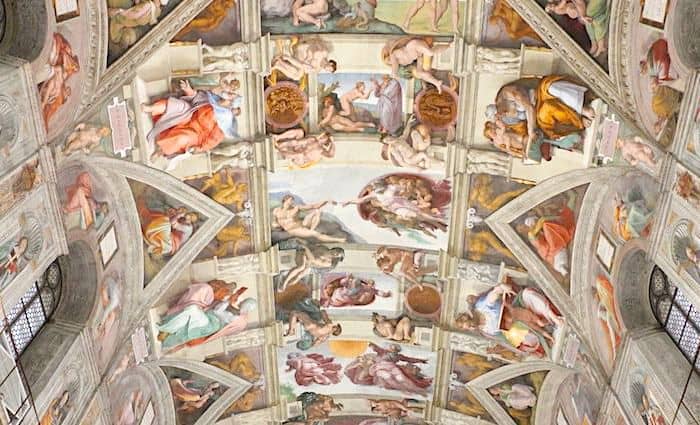
As a licensed tour guide of Rome and the Vatican, I have visited the Sistine Chapel over 3,000 times. I can say even now, that it is by far one of the most amazing creations of art I have ever seen. It is something you never tire to look at, ever.
The Sistine Chapel is in the official residence of the Pope, the Apostolic Palace. Originally known as the Cappella Magna, the chapel’s “new” name came from Pope Sixtus IV. Pope Sixtus IV committed to restoring the chapel between 1477 and 1480. Today, the Sistine Chapel serves as a private chapel of the pope. It also serves as the meeting place for cardinals around the world to come together and elect a new pope in what is called the Conclave.
The Sistine Chapel is often considered one of the most famous landmarks in the world. People flock from all over the world to experience the immensity of the artwork of this holy chapel. Additionally, people most closely associate the beauty of the Sistine Chapel with its floor to ceiling frescoes. Many of Italy’s most celebrated Renaissance artists contributed to the beautiful artwork we see today in the Sistine Chapel.
So, the answer to the age-old question: How many artists helped to paint the Sistine Chapel. Therefore, there are really two answers to this question. To simplify it, we will break it down into Early Renaissance artists and then Michelangelo. When you walk in today you will see the side panels and the ceiling. Early Renaissance painters painted the side panels and Michelangelo painted the ceiling. Make sense? Let’s go more in-depth.
The Early Renaissance Painters
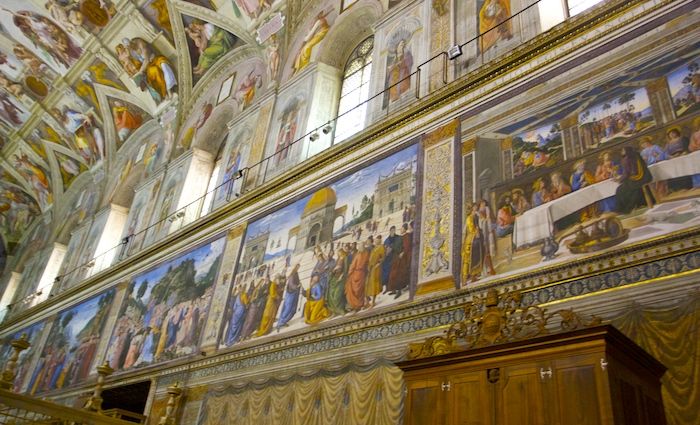
These first painters were brought in to paint the side walls of the chapel. There are two themes with the right side ( having your back to the last judgement) telling stories about Moses. The left side portrays stories about the life of Jesus.
So who were these early Renaissance painters? They were basically the most famous painters on the planet ( in Western civilization at least). These early masters lived one generation before painters such as Michelangelo, Raphael, and Da Vinci.
They came from various cities, but I will name them here:
- Pietro Perugino
- Sandro Botticelli
- Biagio D’Antonio
- Cosimo Rosselli
- Luca Signorelli
- Domenico Ghirlandaio
If you don’t happen to know the names above, don’t worry. I would say the majority of people who have not studied art history do not know them so it’s ok. The most important takeaway from the artists above is the fact that they made beautiful artwork. They also inspired later artists to produce even more beautiful artwork.
To hit this point home, Pietro Perugino was Raphael’s teacher and Ghirlandaio was Michelangelo’s teacher. This lets you know how important these artists were in order to push the next generation to the highest level the world has ever seen as far as artwork. Speaking of Michelangelo, let’s discuss the master
Michelangelo’s Early Years
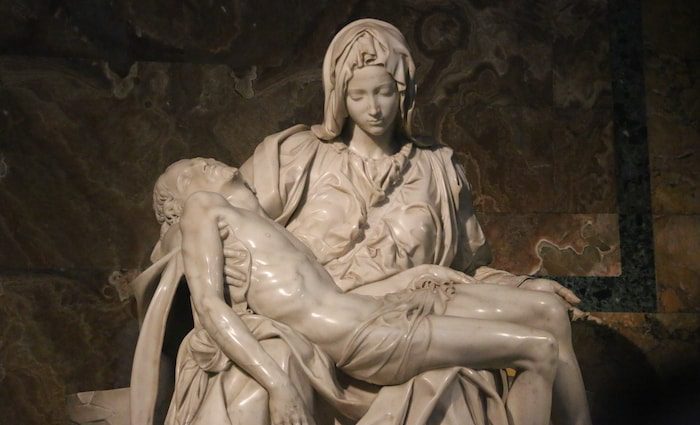
Michelangelo was born to a middle-class family just outside of Arezzo in 1475. Tragedy struck him young as his mother died when he was only 6 years old.
Consequently, he was sent to live with stone-cutters in the Tuscan countryside. This set the stage for his future, epitomized in a famous quote through his biographer Vasari:
“If there is some good in me, it is because I was born in the subtle atmosphere of your country of Arezzo. Along with the milk of my nurse I received the knack of handling chisel and hammer, with which I make my figures.”
Michelangelo’s father was set on his son working an administrative job like he did, but was upset when he realized that the future master preferred sketching buildings and artwork than his studies. As a result, he eventually gave in and set him up with an art apprenticeship. At age 13, Michelangelo began to work with prominent Renaissance artist Domenico Ghirlandaio. Can you imagine the loss to the world if his father persevered in making him study?
Luck would have it that soon after, Lorenzo the Great of Florence asked Ghirlandaio for two of his best pupils- one of them was Michelangelo. Throughout history, there could not have been a more exciting time to be an artist living in Florence. Florence was a bustling city full of merchants growing rich and therefore perfect patrons, together with the Catholic church to support this beautiful period of re-birth known as the Renaissance.
For two years living at the court of Lorenzo the Great, Michelangelo was able to not only learn the skills needed but also mingle with the greatest minds of society at the time.
Not ready to book a tour? Find out if a Sistine Chapel tour is worth it!
Michelangelo’s Early Projects
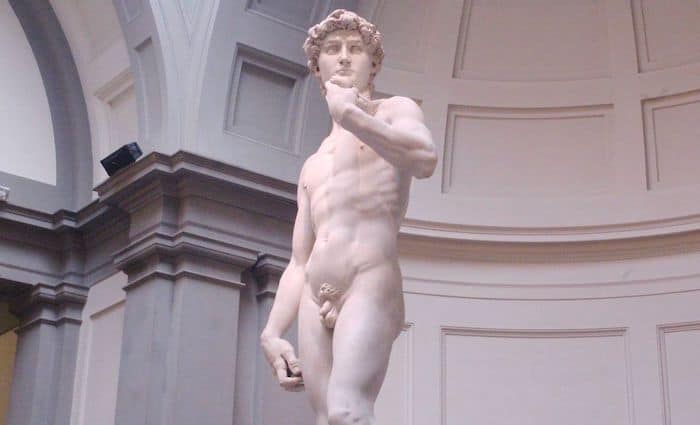
The Pietá
Michelangelo’s two main early works were the Pieta and the David. To better understand the artist, we need to discuss these two pieces just a bit. Michelangelo sculpted La Pietà at the very end of the 15th century and depicts Jesus after his crucifixion laying in Mary’s lap. A French cardinal named Jean de Bilheres commissioned Michelangelo to create a sculpture to go into a side chapel of St. Peter’s Basilica in 1497.
With a large block of Carrara marble and his irrefutable artistic craft, Michelangelo within a year created this incredibly detailed work of art. When he finished the statue, he was still relatively unknown at 24 years old, so people starting attributing the statue to someone else. That pushed him to actually carve his name in the statue writing Michelangelo from Florence has made this.
The David
David is the main attraction in the Accademia art gallery and without argument is the most visited sculpture in Florence. Michelangelo “freed” David from his marble prison in three years. This enormous statue is 17 feet tall and modeled after the old-testament figure who defeated Goliath at the Valley of Elah when the Israelites (David) fought the Philistines (Goliath). The statue is considered Michelangelo’s masterpiece, at least in terms of sculpting.
The Statue of David gets its undoubted fame for a few reasons. Its creator, Michelangelo, was the only sculptor at the time willing to work with this particular type of marble. Out of undesirable marble came one of the most desirable and striking works of art known in history.
Besides the height of the statue, did you know that his feet are also huge? The statue was actually sculpted to adorn the roof of Florence’s Cathedral Dome. Given that prior knowledge, Michelangelo made David’s feet a bit bigger to make the statue more sturdy. However, David never set foot on top of the Cathedral and today, people question his unproportioned feet from the inside of the Gallery.
Why was Michelangelo Chosen to Paint the Sistine Chapel?
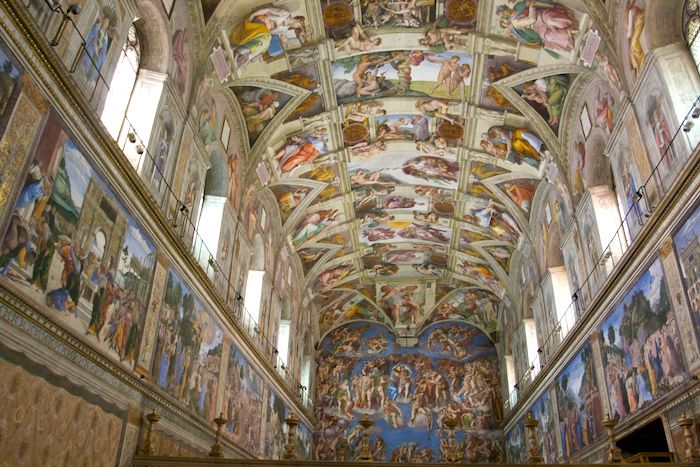
In 1505, Michelangelo was back in Rome working on a monumental tomb for Pope Julius II. As the story goes, Bramante who was upset with Michelangelo for a previous slight suggested to the Pope that Michelangelo should paint the ceiling even though he was a sculptor and not a painter. Julius agreed and pretty much against Michelangelo’s will, he signed the contract to paint the ceiling.
Ironically, Michelangelo was not happy about the commission and supposedly even tried to run away from Rome! .The original design was to be the twelve apostles, but after Michelangelo objected, Julius put the design in the Master’s hands and the rest is history.
Michelangelo had many problems/hardships going into this job. Let’s name a few so you get an idea:
- Michelangelo was a sculptor, not a painter
- He had to paint in fresco but had never really painted in this medium, so basically, his first attempt at fresco painting becomes the most famous painting in the world
- He had to build his own scaffolding first to even reach the ceiling which was 60ft high
- Since he was a perfectionist, he basically painted the entire thing by himself
- No centralized heating, so he complained of stifling heat in the summer and numbing cold in the winter
- Developed an eye disease during the painting, which only went away once he finished the ceiling years later
Why is the Sistine Chapel a Masterpiece?
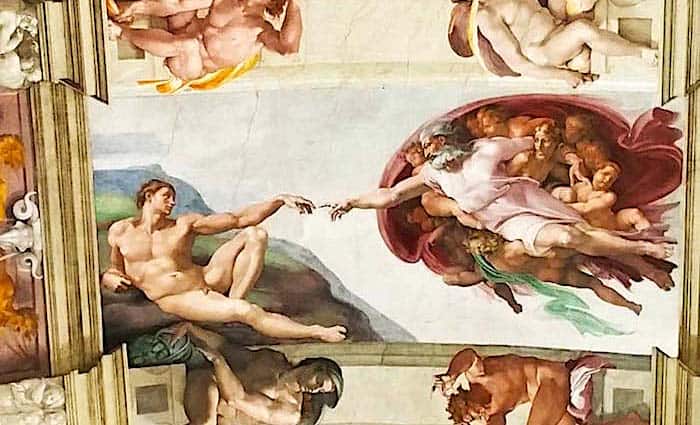
When Michelangelo set out to paint the ceiling of the Chapel, he had to paint in fresco. Fresco painting is when you apply a coating of plaster to a wall and before it dries completely, you paint on top of it. As the plaster dries, the colors are absorbed into the plaster, making it last forever.
The downside is that if you make a mistake, you need to break the plaster and start all over again. This is why painting in fresco is so difficult! And to top it off, this would be Michelangelos’ first real attempt at Fresco painting!
In the beginning he brought in some friends to help, but later let them go and did the entire ceiling by himself! It took him 4 years to conclude the painting and in essence had created an entire new style of painting.
His figures were strong, with huge muscles- even the women.
His style was copied by many artists, including Raphael in the papal apartments. However, none managed to capture it the way Michelangelo could. To quote Edvard Munch:
“One can easily tell that the creator of the paintings in the Sistine Chapel was above all a sculptor.”
Michelangelo’s Later Years
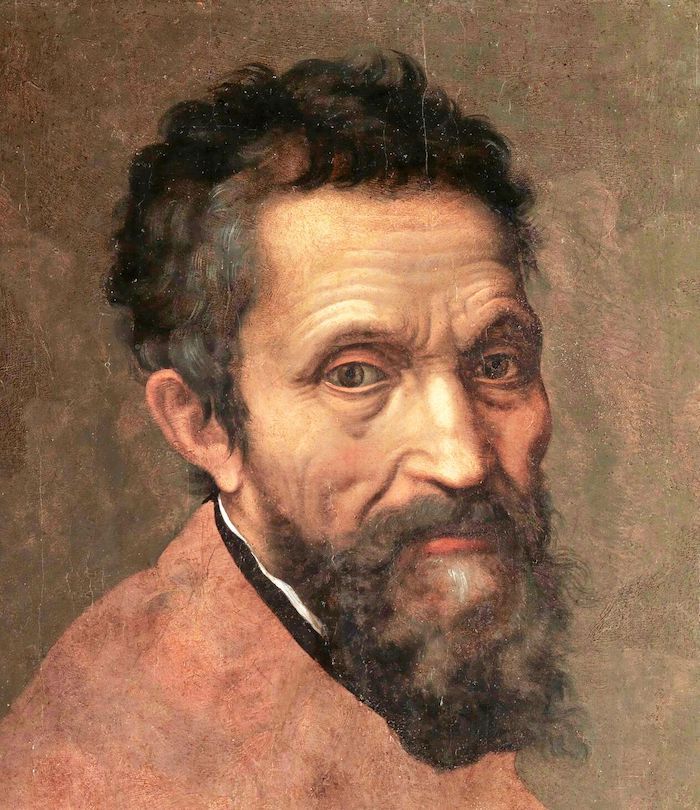
After the completion of the Sistine Chapel ceiling, Michelangelo sealed his fate as one of the most famous Renaissance artists. He was a rare artist who enjoyed not only wealth during his lifetime, but also 2 biographies written by contemporaries.
He went on to complete many more masterpieces, including the monumental back wall of the Sistine chapel- The Last Judgement.
Astoundingly, Michelangelo lived until he was 88 years old, which was extremely rare in those times. Although he died in Rome, his body was sent back to Florence where he rests to this day in the Basilica di Santa Croce.
Not ready to book a tour? Check out our Vatican Guide for more info.

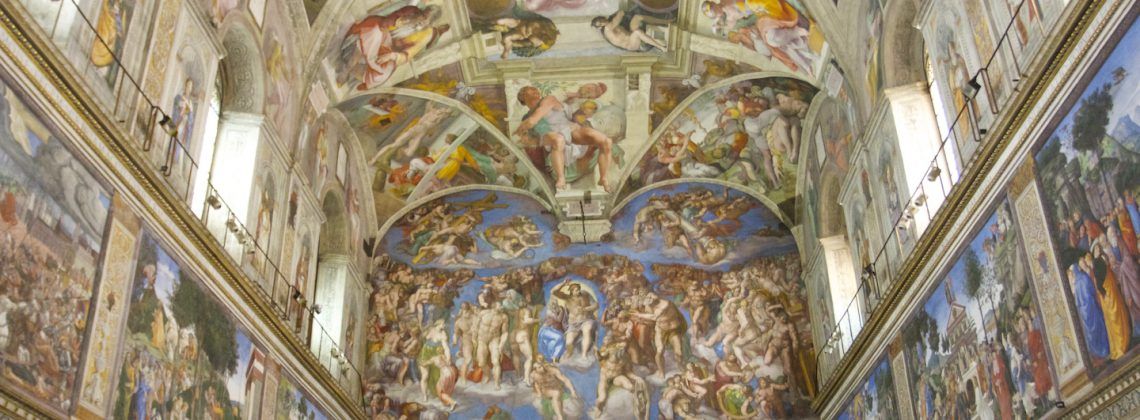
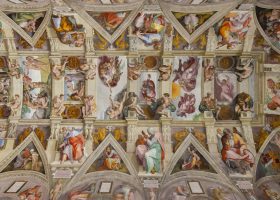
What I would like to know is who are the other artists who worked on the sistine chapel? Contrary to what others say Angelo did not work on it alone. He had a team who not only mixed the plaster but also traced the outline of the designs (pricking through them and then outlining them in black. Angelo just filled in the detail. Of all those that worked on it only Angelo gets all the credit.
Ciao! Very good question. The frescoes in the Sistine Chapel were painted by Sandro Botticelli, Pietro Perugino,Pinturrichio, Domenico Ghirlandaio and Cosimo Rosselli. Explore these amazing frescoes on our Vatican tours!
Italy is number one on the list for countries I have to visit, it holds so much beauty and home to renaissance artist Michelangelo the artist whose hand birth some of the world’s greatest pieces recorded in all of mankind, and The Sistine Chapel falls no short from that. Having no doubt in mind it’s wonder is why The Sistine Chapel is where the work of God happens. Having said that, bear in mind that I’m yet to see it’s beauty and craftsmanship in person but came to this conclusion from common knowledge and visuals of his works from virtual museums that has bemused me to how one man could spend almost 10 years of his life working on such a piece, this has taught me not only dedication, but discipline, teamwork and commitment to one’s craft and in anything one sets out to do in life in order to achieve a dream or set goal.
Ciao Emmanuel. Thanks so much for taking the time to read our blog. It really shows that you are passionate about Michelangelo and his work on the Sistine Chapel When you do have the chance to visit, we recommend our Vatican tours to see the Sistine Chapel.
Is it possible to take non-flash photos in the Sistine Chapel during the early morning tour?
Ciao John! In fact, taking any photos at all in the Sistine Chapel is forbidden, unfortunately!
I am really impressed with you for the selecting of new and unique topic.Your blog provided best tips for everyone. Looking forward to reading these kinds of articles. I appreciate your nicely descriptive and elaborate article. I hope you continue to have high quality articles like this to share with everyone!. Thanks for sharing this blog. Keep posting!!.